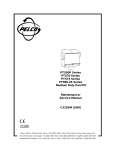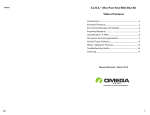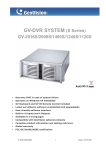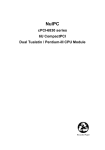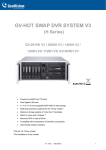Download Mag-Bind®mRNA Kit - Omega Bio-Tek
Transcript
Mag-Bind® mRNA Kit R6570-00 R6570-01 July 2013 2 preps 10 preps Mag-Bind® mRNA Kit Table of Contents Introduction and Overview.......................................................2 Kit Contents/Storage and Stability.........................................3 Before Beginning...........................................................................4 Analysis of Extracted RNA..........................................................5 Standard Protocol..........................................................................6 Centrifugation Protocol............................................................10 Troubleshooting Guide.............................................................14 Ordering....................................................................................15 Manual Revision: July 2013 Innovations in nucleic acid isolation 1 Introduction and Overview High purity mRNA is critical for downstream applications such as RT-PCR and qRT-PCR, The Mag-Bind® mRNA Kit provides a convenient and rapid method for the isolation of high purity mRNA from tissue and total RNA samples. This kit is based on Mag-Bind® oligo(dT) Particles which have a large surface compared to other standard magnetic beads and delivery high purity mRNA. The magnetic bead format also can be easily scaled up and down according to the starting sample amount, offering flexibility for a variety of downstream applications. If using the Mag-Bind® mRNA Kit for the first time, please read this booklet in its entirety to become familiar with the procedures. The sample is lysed under highly denaturing conditions which inactivate RNases and protect the intact tissue RNA from degradation. Total cellular RNA is precipitated with isopropanol and resuspended. The Mag-Bind® oligo(dT) Particles are mixed with the total RNA solution. Poly(A)+ RNA hybridizes to the Mag-Bind® oligo(dT) Particles under optimized conditions. After applying the magnetic field, the magnetic particle/mRNA complexes are pulled out of the solution. Contaminants are removed by aspiration, and then the magnetic beads are thoroughly washed by two quick wash steps. Purified mRNA is eluted from the magnetic particles in an aqueous solution. Binding Capacity: Each 100 µL Mag-Bind® oligo(dT) can bind ~1.5 µg mRNA. New in this Edition: This manual has been edited for content and redesigned to enhance user readability. 2 Kit Contents Product R6570-00 R6570-01 2 10 110 µL 550 µL 3 x 1 mL 15 mL 2X mRNA Binding Buffer 500 µL 5 mL mRNA Wash Buffer 500 µL 3 mL mRNA Elution Buffer* 500 µL 1.5 mL P P Purifications Mag-Bind® oligo(dT) Particles RNA-Solv User Manual * mRNA Elution Buffer is 5 mM Tris HCl pH 7.0 Storage and Stability All of the Mag-Bind® mRNA Kit components are guaranteed for at least 12 months from the date of purchase when stored as follows. The Mag-Bind® oligo(dT) Particles should be stored at 2-8°C for long-term use. All remaining components should be stored at room temperature. Under these conditions, RNA has successfully been purified and used for RTPCR after 12 months of storage. Do not freeze the Mag-Bind® oligo(dT) Particles. 3 Before Beginning Important Notes WARNING: This reagent is toxic if swallowed and can causes burns when in contact with skin. After contact with skin, wash immediately with copious amounts of mild detergent and water. If you feel sick, seek medical advice at once and Quote UN2821. Please take a few minutes to read this booklet in its entirety to become familiar with the procedures. Prepare all materials required before starting to minimize RNA degradation. • Whenever working with RNA, always wear gloves to minimize RNase contamination. • Use sterile, disposable plastic ware and automatic pipettes reserved for RNA work to prevent cross-contamination with RNases. • In the presence of RNA-Solv® Reagent, RNA is protected from RNase contamination. Downstream sample handling requires that non-disposable glassware or plastic ware be RNase-free. • Work quickly, but carefully. • All centrifugation steps must be carried out at room temperature. • Prepare all materials required before starting the procedure to minimize RNA degradation. 4 Analysis of Extracted RNA Expected Yields Expected RNA yield per 1 mg tissue or 1 x 106 cells can be found in the table below. Tissue Source Expected RNA Yield Liver or Spleen 5-10 μg Kidney 2-5 μg Brain 1-2 μg Endothelial Cells 7-12 μg Fibroblasts 6-8 μg Quantification and Storage of RNA To determine the concentration and purity of RNA, measure absorbance at 260 nm and 280 nm with a spectrophotometer. One OD unit measured at 260 nm corresponds to 40 μg/mL RNA. DEPC-treated water is slightly acidic and can dramatically lower absorbance values. We suggest that you dilute the sample in a buffered solution (TE) for spectrophotometric analysis. The A260/A280 ratio of pure nucleic acids is 2.0, while an A260/A280 ratio of 0.6 denotes pure protein. A ratio of 1.8-2.0 corresponds to 90%-100% pure nucleic acid. Phenol has a maximum absorbance at 270 nm and can interfere with spectrophotometric analysis of DNA or RNA. Store RNA samples at -70°C in water. Under these conditions, RNA is stable for more than a year. RNA Concentration = 40 μg/mL x Dilution factor x Abs 260 nm Integrity of RNA It is highly recommended that RNA quality be determined prior to beginning all downstream applications. The quality of RNA can be best assessed by denaturing agarose gel electrophoresis with ethidium bromide staining. The ribosomal RNA bands should appear as sharp, clear bands on the gel. The 28S band should appear to be double that of the 18S RNA band (23S and 16S if using bacteria). If the ribosomal RNA bands in any given lane are not sharp and appear to be smeared towards the smaller sized RNA, it is very likely that the RNA undergone degradation during the isolation, handling, or storage procedure. RNA-Solv® Reagent isolates the full spectrum of RNA, including 4S and 5S species. 5 Mag-Bind® mRNA Kit Protocols Mag-Bind® mRNA Kit Protocol - Standard Protocol This protocol is for isolation of mRNA from up to 100 mg tissue or 5 x 106 cells. This protocol can be scaled according to your starting amount. When scaling up or down, simply increase or decrease the volume of all reagents including the Mag-Bind® oligo(dT) Particles. Materials and Equipment to be Supplied by User: • • • • • • • • • • • • Magnetic Separation Device for 1.5 mL microcentrifuge tubes Refrigerated microcentrifuge capable of 12,000 x g Water baths, heat blocks, or ovens capable of 70°C Vortexer Nuclease-free 1.5 mL microcentrifuge tubes RNase-free water Isopropanol Chloroform Optional: 0.5% SDS solution Optional: 100% ethanol at -20°C Optional: 5M NaCl Optional: 70% ethanol Before Starting: • • Heat water bath, heat block, or oven to 55°C Heat water bath, heat block, or oven to 70°C 1. Homogenization and lysis of samples. Choose one method below based on the starting material. • Tissue Samples 1. Homogenize tissue samples in 1 mL RNA-Solv® Reagent per 50-100 mg of tissue using an appropriate mechanical homogenizer. Note: Alternatively one can pulverize tissue in liquid nitrogen with a mortar and pestle. Transfer the powder to a clean 1.5 ml microcentrifuge tube. If a mortar and pestle are not available, homogenize the sample in the microcentrifuge tube using a disposable 1.5 mL pestle. The sample volume should not exceed 10% of the volume of RNA-Solv® Reagent used. 6 Mag-Bind® mRNA Kit Protocols • Cells Grown in Suspension 1. Pellet cells by centrifugation. Do not wash cells. Note: Washing cells before addition of RNA-Solv® Reagent should be avoided as this increases the possibility of mRNA degradation and RNase contamination. 2. Add 1 mL RNA-Solv® Reagent to 5-10 x 106 of animal, plant, or yeast cells, or to 1 x 108 bacterial cells. Tip: For plant, fungal, and yeast cells, mechanical or enzymatic homogenization may be required. Alternatively, we recommend the use of the E.Z.N.A.® Plant (Cat# R6627), Fungal (Cat# R6640), and Yeast (Cat# R6670) RNA Kits from Omega Bio-tek. • Cells Grown in Monolayer 1. Add 1 mL RNA-Solv® Reagent directly to a 3.5 cm diameter culture dish and pipette to lyse the cells. Note: The amount of RNA-Solv® Reagent required is based on the area of the culture dish (~1 mL per 10 cm2 ). An insufficient amount of RNA-Solv® Reagent may result in DNA contamination of the isolated RNA. Always use more RNA-Solv® Reagent if the lysate is too viscous to aspirate with a pipette. 2. Add 0.2 mL chloroform per 1 mL RNA-Solv® Reagent. Cap sample tubes securely and vortex vigorously for 15 seconds. 3. Incubate on ice for 10 minutes. This step is critical. Do not change it. 4. Centrifuge at 13,000 x g for 5 minutes at 4°C. Note: The mixture separates into a lower phenol-chloroform phase, an interphase, and an upper aqueous phase. RNA separates into the aqueous phase. 5. Transfer no more than 80% of the aqueous phase to a fresh microcentrifuge tube. 6. Add 500 μL isopropanol per 1 mL RNA-Solv® Reagent used in Step 1. Invert 10-20 times to mix. 7 Mag-Bind® mRNA Kit Protocols 7. Let sit at room temperature for 10 minutes. 8. Centrifuge at ≤12,000 x g for 10 minutes. 9. Aspirate and discard the supernatant. 10. AIR DRY the RNA pellet at room temperature for 5-10 minutes. Note: Do not use centrifugal devices equipped with a vacuum source as over drying will lead to difficulty in resuspension of the RNA in water. 11. Add 100 μL RNase-free water or 0.5% SDS solution. Vortex for 20 seconds. 12. Incubate at 55°C for 10 minutes to completely dissolve the RNA pellet. 13. Add 50 μL Mag-Bind® oligo(dT) Particles. Gently shake to mix thoroughly. Note: Completely resuspend the Mag-Bind® oligo(dT) Particles before use. 14. Add 150 μL 2X mRNA Binding Buffer. Pipet up and down to mix thoroughly. 15. Incubate at 70°C for 3 minutes. 16. Let sit at room temperature for 10 minutes. 17. Place the tube on a magnetic separation device to magnetize the Mag-Bind® oligo(dT) Particles. Let sit at room temperature until the Mag-Bind® oligo(dT) Particles are completely cleared from solution. 18. Aspirate and discard the cleared supernatant. Do not disturb the Mag-Bind® oligo(dT) Particles. 19. Remove the tube from magnetic separation device. 8 Mag-Bind® mRNA Kit Protocols 20. Add 200 µL mRNA Wash Buffer. Vortex for 20 seconds. 21. Place the tube on a magnetic separation device to magnetize the Mag-Bind® oligo(dT) Particles. Let sit at room temperature until the Mag-Bind® oligo(dT) Particles are completely cleared from solution. 22. Aspirate and discard the cleared supernatant. Do not disturb the Mag-Bind® oligo(dT) Particles. 23. Leave the tube on the magnetic separation device for 10 minutes to air dry the MagBind® oligo(dT) Particles. Remove any residue liquid with a pipettor. 24. Remove the tube from magnetic separation device. 25. Add 100 μL mRNA Elution Buffer. Resuspend the Mag-Bind® oligo(dT) Particles by pipetting up and down. 26. Let sit at room temperature for 5 minutes. Gently mix 2-3 times during incubation. 27. Place the tube on a magnetic separation device to magnetize the Mag-Bind® oligo(dT) Particles. Let sit at room temperature until the Mag-Bind® oligo(dT) Particles are completely cleared from solution. 28. Transfer the cleared supernatant to a RNase-free 1.5 mL microcentrifuge tube. 29. Store at -80°C. Optional Ethanol Precipitation Step 1. 2. 3. 4. 5. 6. Add 10 µL 5M NaCl and 2 volumes cold 100% ethanol. Incubate at -20°C for 20 minutes. Centrifuge at maximum speed for 10 minutes at room temperature. Wash once with 300 µL 70% ethanol. Dissolve the purified mRNA with 10-20 µL RNase-free water. Store at -80°C. 9 Mag-Bind® mRNA Kit Protocols Mag-Bind® mRNA Kit Protocol - Centrifugation Protocol This protocol is for isolation of mRNA from up to 100 mg tissue or 5 x 106 cells. This protocol can be scaled according to your starting amount. When scaling up or down, simply increase or decrease the volume of all reagents including the Mag-Bind® oligo(dT) Particles. Materials and Equipment to be Supplied by User: • • • • • • • • • • • • Magnetic Separation Device for 1.5 mL microcentrifuge tubes Refrigerated microcentrifuge capable of 12,000 x g Water baths, heat blocks, or ovens capable of 70°C Vortexer Nuclease-free 1.5 mL microcentrifuge tubes RNase-free water Isopropanol Chloroform Optional: 0.5% SDS solution Optional: 100% ethanol at -20°C Optional: 5M NaCl Optional: 70% ethanol Before Starting: • • Heat water bath, heat block, or oven to 55°C Heat water bath, heat block, or oven to 70°C 1. Homogenization and lysis of samples. Choose one method below based on the starting material. • Tissue Samples 1. Homogenize tissue samples in 1 mL RNA-Solv® Reagent per 50-100 mg of tissue using an appropriate mechanical homogenizer. Note: Alternatively one can pulverize tissue in liquid nitrogen with a mortar and pestle. Transfer the powder to a clean 1.5 ml microcentrifuge tube. If a mortar and pestle are not available, homogenize the sample in the microcentrifuge tube using a disposable 1.5 mL pestle. The sample volume should not exceed 10% of the volume of RNA-Solv® Reagent used. 10 Mag-Bind® mRNA Kit Protocols • Cells Grown in Suspension 1. Pellet cells by centrifugation. Do not wash cells. Note: Washing cells before addition of RNA-Solv® Reagent should be avoided as this increases the possibility of mRNA degradation and RNase contamination. 2. Add 1 mL RNA-Solv® Reagent to 5-10 x 106 of animal, plant, or yeast cells, or to 1 x 108 bacterial cells. Tip: For plant, fungal, and yeast cells, mechanical or enzymatic homogenization may be required. Alternatively, we recommend the use of the E.Z.N.A.® Plant (Cat# R6627), Fungal (Cat# R6640), and Yeast (Cat# R6670) RNA Kits from Omega Bio-tek. • Cells Grown in Monolayer 1. Add 1 mL RNA-Solv® Reagent directly to a 3.5 cm diameter culture dish and pipette to lyse the cells. Note: The amount of RNA-Solv® Reagent required is based on the area of the culture dish (~1 mL per 10 cm2 ). An insufficient amount of RNA-Solv® Reagent may result in DNA contamination of the isolated RNA. Always use more RNA-Solv® Reagent if the lysate is too viscous to aspirate with a pipette. 2. Add 0.2 mL chloroform per 1 mL RNA-Solv® Reagent. Cap sample tubes securely and vortex vigorously for 15 seconds. 3. Incubate on ice for 10 minutes. This step is critical. Do not change it. 4. Centrifuge at 13,000 x g for 5 minutes at 4°C. Note: The mixture separates into a lower phenol-chloroform phase, an interphase, and an upper aqueous phase. RNA separates into the aqueous phase. 5. Transfer no more than 80% of the aqueous phase to a fresh microcentrifuge tube. 6. Add 500 μL isopropanol per 1 mL RNA-Solv® Reagent used in Step 1. Invert 10-20 times to mix. 11 Mag-Bind® mRNA Kit Protocols 7. Let sit at room temperature for 10 minutes. 8. Centrifuge at ≤12,000 x g for 10 minutes. 9. Aspirate and discard the supernatant. 10. AIR DRY the RNA pellet at room temperature for 5-10 minutes. Note: Do not use centrifugal devices equipped with a vacuum source as over drying will lead to difficulty in resuspension of the RNA in water. 11. Add 100 μL RNase-free water or 0.5% SDS solution. Vortex for 20 seconds. 12. Incubate at 55°C for 10 minutes to completely dissolve the RNA pellet. 13. Add 50 μL Mag-Bind® oligo(dT) Particles. Gently shake to mix thoroughly. Note: Completely resuspend the Mag-Bind® oligo(dT) Particles before use. 14. Add 150 μL 2X mRNA Binding Buffer. Pipet up and down to mix thoroughly. 15. Incubate at 70°C for 3 minutes. 16. Let sit at room temperature for 10 minutes. 17. Centrifuge at 8,000 x g for 1 minute. 18. Carefully aspirate and discard the supernatant. Do not disturb the Mag-Bind® oligo(dT) Particles. 19. Add 200 µL mRNA Wash Buffer. Vortex for 20 seconds. 20. Centrifuge at 8,000 x g for 1 minute. 12 Mag-Bind® mRNA Kit Protocols 21. Carefully aspirate and discard the supernatant. Do not disturb the Mag-Bind® oligo(dT) Particles. 22. Repeat Steps 19-21 for a second mRNA Wash Buffer wash step. 23. Air dry for 10 minutes. Remove any residue liquid with a pipettor. 24. Add 100 μL mRNA Elution Buffer. Resuspend the Mag-Bind® oligo(dT) Particles by pipetting up and down. 25. Let sit at room temperature for 5 minutes. Gently mix 2-3 times during incubation. 26. Centrifuge at 10,000 x g for 2 minutes. 27. Transfer the cleared supernatant to a RNase-free 1.5 mL microcentrifuge tube. 28. Store at -80°C. Optional Ethanol Precipitation Step 1. 2. 3. 4. 5. 6. Add 10 µL 5M NaCl and 2 volumes cold 100% ethanol. Incubate at -20°C for 20 minutes. Centrifuge at maximum speed for 10 minutes at room temperature. Wash once with 300 µL 70% ethanol. Dissolve the purified mRNA with 10-20 µL RNase-free water. Store at -80°C. 13 Troubleshooting Guide Please use this guide to troubleshoot any problems that may arise. For further assistance, please contact the technical support staff, toll free, at 1-800-832-8896. Problem Cause RNase contamination from handling Solution • • Follow protocol closely and work quickly Wear gloves throughout the procedure and when handling the solution and equipment used for RNA isolation • Ensure not to introduce RNase during the procedure Check total RNA sample for RNase contamination: 1. Incubate the total RNA sample at 70°C for 5 minutes and then let sit at room temperature for 10 minutes 2. Analyze the sample by agarose gel electrophoresis (RNase contamination can be determined by loss or smear of 18S and 28S rRNA bands) • Degraded RNA RNase contamination from total RNA sample Problem Cause Solution • Ensure total RNA sample is heated at 70°C prior to the addition of Mag-Bind® oligo(dT) Particles If the rRNA level is too high for downstream applications, purify the mRNA again with fresh Mag-Bind® oligo(dT) Particles rRNA rRNA co-purified contamination with mRNA • Problem Cause Solution Magnetic beads interference Completely remove the Mag-Bind® oligo(dT) Particles by magnetic separation device or centrifugation A260/A280 ratio is too low 14 Ordering Information The following components are available for purchase separately. (Call Toll Free at 1-800-832-8896) Product Magnetic Separation Device for 1.5 mL Microcentrifuge Tubes Part Number MSD-02 Homogenization Pestles, 1.5 mL, 10/bag, 20 bags/cs SSI-1015-39 DNase/RNase Free Microcentrifuge Tubes, 1.5 mL, 500/pk, 10 pk/cs SSI-1210-00 RNA-Solv, 100 mL R6830-01 RNA-Solv, 200 mL R6830-02 HiBind®, E.Z.N.A.®, and MicroElute® are registered trademarks of Omega Bio-tek, Inc. Qiagen®, QIAvac® and Vacman® are all trademarks of their respective companies. PCR is a patented process of Hoffman-La Roche. Use of the PCR process requires a license. 15 Notes: 16

















